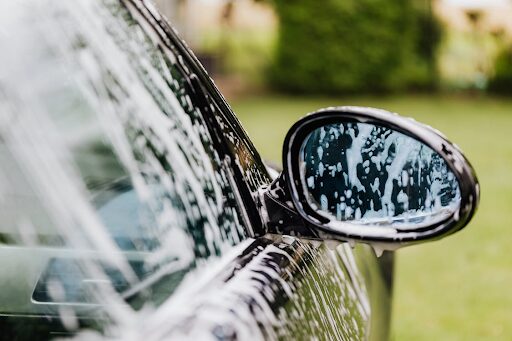Shampooing your car seats is a great method to revitalize the interior of your car, removing deep-seated filth, stains, and aromas that build up over time and leaving it looking cleaner and more comfortable. How to dry car seats after shampooing? By eliminating bacteria and allergens that are trapped in the upholstery, it not only improves the comfort and appearance of your vehicle but also helps create a healthier driving environment. Inappropriate handling of the residual moisture can result in a number of problems, including the development of mold and mildew, disagreeable musty smells, fabric deterioration, and even long-term harm to the upholstery and foam underneath.
These issues can eventually lower your car’s resale value in addition to compromising its comfort and cleanliness. In order to keep your car’s interior clean, fresh, and damage-free, this tutorial will show you the most effective and useful ways to dry car seats after shampooing.
Why It’s Important to Properly Dry Car Seats
It’s important to comprehend why appropriate drying is vital before beginning the detailed instructions:
- Prevents mildew and mold: Your car’s moist interior presents the ideal conditions for the growth of mold.
- Avoid undesirable scents: Musty, disagreeable aromas can come from damp seats.
- Safeguards the foam padding: The foam beneath the upholstery may disintegrate due to excessive dampness.
- Assures comfort: It is hard and unpleasant to sit on damp automobile seats.
- Preserves upholstery quality: Proper drying speeds up the deterioration of synthetic materials, leather, and cloth.
Now, let’s see how to complete the task properly.
How to Dry Car Seats After Shampooing: A Comprehensive Guide
Cleaning the chairs isn’t the end of the process. Just as vital, if not more so, than cleaning your car seats is thoroughly drying them afterward. Knowing how to properly dry car seats is crucial, whether you’re a car detailing enthusiast hoping for expert-caliber results or just an owner attempting to maintain the finest possible condition for your vehicle.
1. Extract Extra Moisture using a Wet/Dry Vacuum
The first and most crucial step after shampooing your seats is to remove as much water as you can. The best equipment for this task is a wet/dry shop vacuum, sometimes known as a wet vac. To remove moisture from the seat’s surface and deeper layers, gently run the vacuum over the entire surface while applying moderate pressure.
Advice: For optimal extraction, move the vacuum slowly and go over each region several times.
2. Use microfiber towels to blot
Blot any leftover moisture with fresh, dry microfiber towels after vacuuming. Allow the towel to absorb the water after pressing it firmly onto the seat. Keep blotting until the towel is almost completely dry. Because microfiber doesn’t leave lint behind and absorbs more water than regular cotton towels, it’s very effective.
3. Allow air to circulate through open car windows and doors.
For automobile seats to dry properly, airflow must be enough. After removing the majority of the moisture, open all the windows or doors to let fresh air in. Leave the doors open for a few hours if you can park your car in a secure location, such as a garage or driveway.
Bonus Tip: To achieve the best natural drying conditions, choose a warm, dry day to shampoo your seat.

4. Use Fans to Dry More Quickly
Install portable fans inside your car to expedite the drying process. To improve evaporation, aim them straight at the seats. The most effective fans are powerful ones, such as oscillating or box fans. A tiny desk fan can make a big difference in drying time.
Important: Run fans until the seats are totally dry, which may take many hours.
5. Switch on the air conditioner or car heater.
Another choice is to switch on the car’s air conditioner or heater if the weather prevents windows from being opened. Put it on the warm or dehumidifying setting and leave the windows slightly cracked for 30 to 60 minutes. This method is particularly helpful in cold or wet seasons when there is less external ventilation.
6. Make Use of a Dehumidifier in the Car
A portable dehumidifier can assist in removing moisture from the seats and cabin of your automobile if you live in a humid region. This works well for absorbing residual moisture and keeping musty odors at bay. Moisture-absorbing items like DampRid or silica gel packs are an affordable choice.
Drying Various Upholstery Types
The care needed for various seat materials varies slightly. Here’s how to deal with each of them:
Seats Made of Fabric
- Make extensive use of microfiber cloths and a wet/dry vacuum.
- When shampooing, try not to oversaturate the cloth.
- Keep doors open and use fans to circulate the air.
Seats Made of Leather
- Avoid wetting the surface and give it a gentle shampoo with a leather-safe cleaner.
- Use a dry towel after wiping down with a microfiber cloth.
- After drying, use a leather conditioner after using a fan or air conditioner to get rid of any remaining moisture.
Vinyl or Synthetic Seats
- These materials are less absorbent and dry more quickly.
- To expedite the process, use fans and microfiber towels.
- Steer clear of extended heat exposure as this could lead to cracking.
How Much Time Does It Take for Car Seats to Dry?
A number of variables affect the drying time, including:
- Type of upholstery
- Weather and humidity levels
- Airflow and ventilation
- Equipment utilized (vacuums, fans, and dehumidifiers)
Fabric vehicle seats normally dry in three to six hours with enough ventilation and vacuuming. Seats made of leather or vinyl may dry more quickly—about one to two hours. Drying could take more than a day without fans or air, which raises the possibility of mold and odors.
Hints That Your Car Seats Aren’t Completely Dry
Are you unsure whether your seats are really dry? Keep an eye out for these indicators:
- To the touch, the seats seem moist or chilly.
- Musty or lingering moisture odor
- Car windows with condensation
- After leaving the automobile overnight, the glass became foggy.
If any of these symptoms appear, act quickly to increase airflow or use the previously described methods to re-dry the impacted regions.
Last Words on How to Dry Quickly and Safely
Here are some additional pointers to guarantee success:
- Don’t hurry: Wait until the seats are completely dry before sitting on them or covering them.
- Make use of absorbent seat covers, which are simple to remove and wash and aid in removing moisture.
- Work in sections: To regulate moisture levels, shampoo and dry one area at a time.
- Clean your chairs on a regular basis to minimize accumulation and use less water each time.
Final thought
Maintaining a clean, fresh, and healthy car interior requires knowing how to dry car seats after shampooing. Mold development, musty smells, and long-term harm to upholstery and foam cushioning are all avoided with proper drying. The drying process can be greatly accelerated with the correct equipment, such as fans, dehumidifiers, microfiber towels, and wet/dry vacuums. Whether you’re a professional detailer or a do-it-yourself car owner, using efficient drying methods can guarantee that your seats stay pleasant, clean, and in top shape. In addition to looking fantastic, a well-dried interior makes for a safer and more enjoyable ride over time.
Frequently Asked Questions
1. After shampooing, how long does it take for vehicle seats to dry?
The type of upholstery, humidity levels, airflow, and equipment used all affect how long it takes to dry. With enough airflow and a wet/dry vacuum, cloth chairs usually take three to six hours to dry. Seats made of leather or vinyl dry more quickly, typically in one to two hours. However, drying could take a whole day or longer without fans or ventilation, which raises the possibility of mold and odors. Use fans, open windows or doors, and park the automobile in a warm, dry location to shorten the drying period. Additionally, a dehumidifier might speed up the procedure.
2. What occurs if you shampoo your automobile seats and then fail to thoroughly dry them?
After shampooing, improper drying of automobile seats can result in a number of dangerous problems. Trapped moisture in upholstery can encourage the growth of mold and mildew, which results in musty, disagreeable smells. It can deteriorate leather or fabric, erode the foam cushioning under the seat cover, and shorten the lifetime and general comfort of your car’s interior over time. Furthermore, too much moisture can cause foggy windows, increase inside allergies, and decrease the value of your automobile when you sell it. Maintaining a clean, healthy, and damage-free interior requires thorough drying.
3. After shampooing automobile seats, what equipment can I use to hasten the drying process?
After shampooing, use a variety of techniques to dry automobile seats fast and effectively. For removing excessive moisture from the surface and deeper foam layers, a wet/dry vacuum is perfect. Remaining water can be effectively blotted with microfiber towels without producing lint. Fans, particularly powerful ones like box fans, aid in the quicker evaporation of moisture. Utilizing the car’s air conditioner or heater in a dehumidifying mode is effective on chilly or humid days. A portable dehumidifier or moisture-absorbing items like DampRid or silica gel packs can greatly accelerate the drying process in extremely damp interior spaces.
4. Before the vehicle seats are completely dry, can I sit on them?
Sitting on automobile seats before they are entirely dry is not advised. By doing this, the drying process may be slowed down, and moisture may be pushed deeper into the foam, making removal more difficult. Additionally, sitting on wet seats can make your clothes wet, which can lead to mold growth and foul odor. Wait until the seats are completely dry to the touch for optimal results; this usually takes 3 to 6 hours for fabric and 1 to 2 hours for leather or vinyl. Before using, always look for indications of moisture to guarantee comfort and hygienic conditions.
5. Which drying technique works best for leather or fabric vehicle seats?
To improve airflow, use fans or open windows, blot with microfiber towels, then use a wet/dry vacuum to remove any remaining water from fabric seats. Ventilation is essential since fabric tends to retain more moisture. Avoid oversaturating when shampooing leather seats. Use microfiber towels to wipe, then use fans or the warm, dry setting on the car’s heater to dry. To keep it from breaking, use a leather conditioner after it has dried. Due to their low absorbency, vinyl seats dry more quickly; to minimize warping, use fans and stay away from extreme heat. Adapting your drying technique to the material will help preserve the lifespan and quality of the seat.








